Other services: Planetmap | Junocam | Jovian impacts | Venus BepiColombo Flyby
[1]
2023-12-29
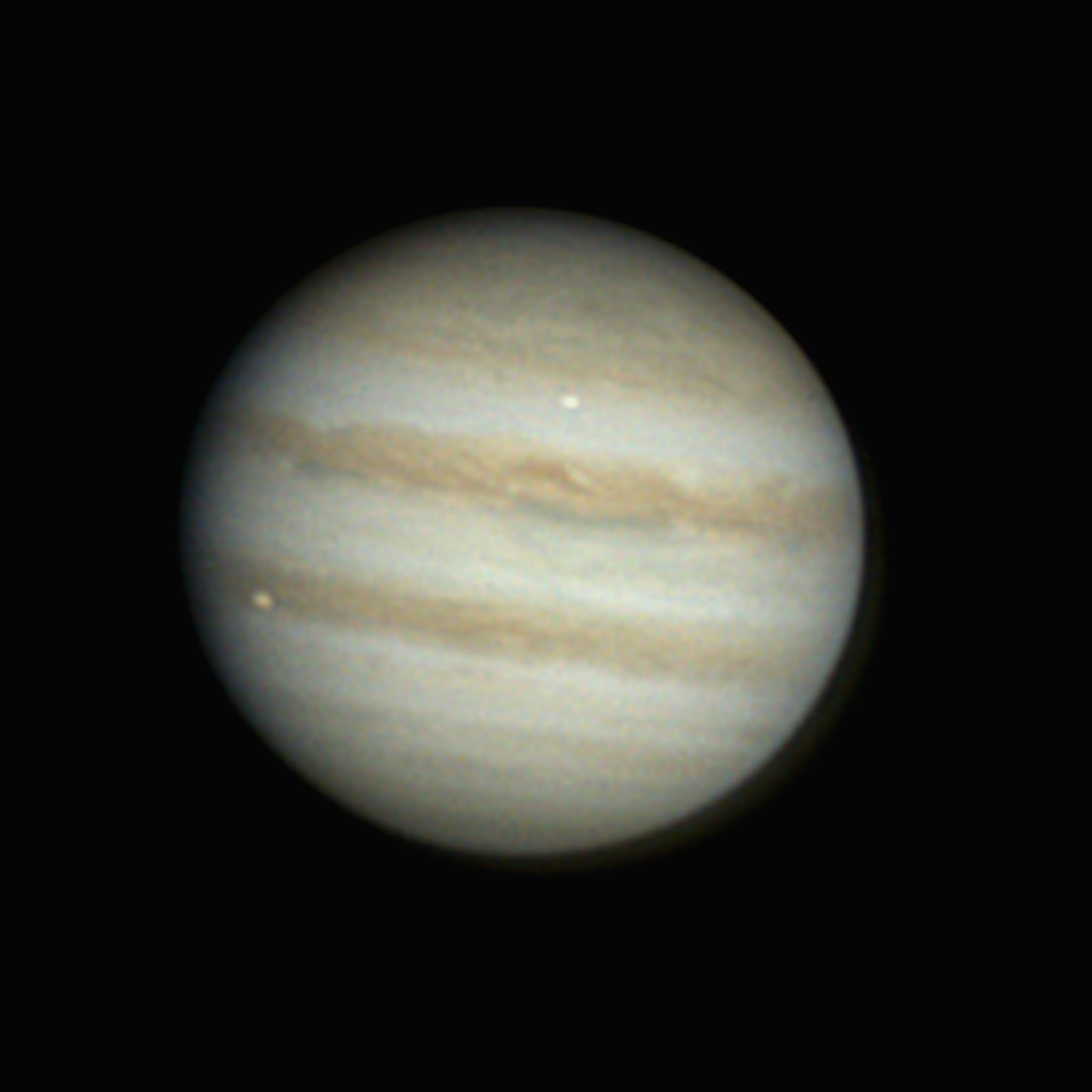
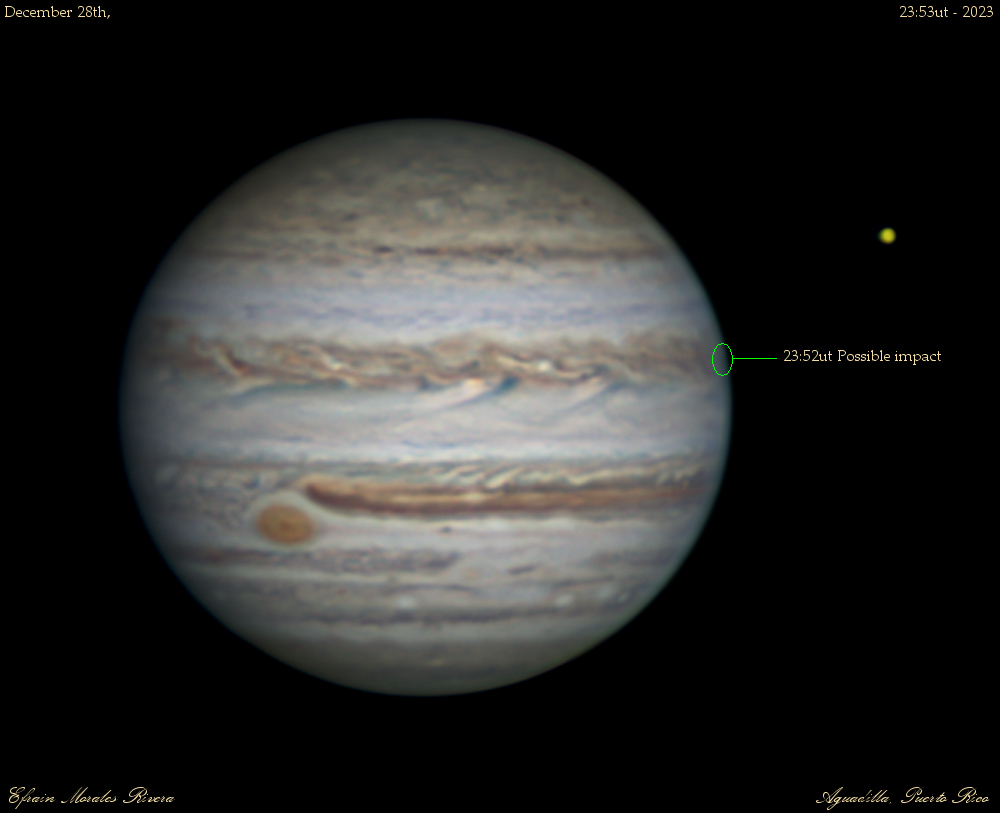 There are two reports of two impacts in Jupiter separated by 24 hr on 28-29 December 2023. If confirmed this could be a series of impacts from a fragmented body colliding with Jupiter over a longer time. Observers interested to follow-up this event should check ALL THEIR VIDEO observations from the last few days and in the next few days to look for potentially new impacts to the two reported below.
There are two reports of two impacts in Jupiter separated by 24 hr on 28-29 December 2023. If confirmed this could be a series of impacts from a fragmented body colliding with Jupiter over a longer time. Observers interested to follow-up this event should check ALL THEIR VIDEO observations from the last few days and in the next few days to look for potentially new impacts to the two reported below.
Impact on December 28, 2023. Status: Not yet confirmed with a video
Efrain Morales, who is an experienced observer from Puerto Rico, spot a bright flash in Jupiter on December 28th around 23:52 UTC. Unfortunately, this was a visual detection on the screen on Efrain's computer, while he was preparing for an image session. The image on the right shows the potential location of the impact. A second report from Brazil with a visual detection too suggests this could be a real impact in Jupiter. If confirmed, this would have been the third impact on Jupiter observed this year. According to Efrain's visual impression of the impact, the bright flash of light on the limb of the planet could have been as bright as a star of magnitude 3 or 4. We encourage all observers who obtained Jupiter videos on December 28th around 23:52 UTC to have a careful look at their video observations of Jupiter.
Observers wishing to obtain images of the impact location and search for a debris field can observe with methane band filters on the 349º-360º(System III) and planetographic latitude 12º.
Impact on December 29, 2023: Status: Video detection
Andrés Arboleda from Colombia observed a second impact on December 29, 2023 at approximate time 23:57-23:58UT. His video observation can be used to extract a light curve and measure the size of the impacting object. Further light curves from other observers are important to better constrain the nature of the impact.
Observers wishing to obtain images of the impact location and search for a debris field can observe with methane band filters on the 221º(System III) and planetographic latitude 30º.
IMPORTANT NOTE ON THESE IMPACTS: The fact that two impacts were reported so closely in time indicates possibilities for further impacts int he next few days. A preliminary image of the impact is shown on the right-most image.
2023-11-16
Japanese observers report a new impact flash in Jupiter. The impact was observed independently by Kunihiko Suzuki, Tsuyoshi Arakawa and Kazuhiro Yamada on 15 November, 2023 at approximate times 12:41:15-12:41:32 UT. The impact was bright and clear with diffraction rings and diffraction spikes. This is the second impact in Jupiter discovered from Japan this year, showing the efficient survey carried by the large number of Japanese amateur observers.You can check ALPO Japan for images by Tsuyoshi Arakawa and X(Twitter) of the different observers to see the videos of the impact.
2023-11-04
With Jupiter at opposition, and many northern hemisphere observers now getting superb high-resolution images, this month is an ideal time for an imaging effort that would, in particular, enable to map the poorly-known flow patterns in the planet’s north polar region (NPR). Some of us made the first detailed study of this region last year [see BAA 2022/23 report no.6], measuring drift rates of some features up to 76°N, and we hope that images this month can yield even better results. Juno’s Perijove-56 is on Nov.22, and JunoCam should be able to get a good map of the planet, including about half the NPR at high resolution. Indeed, this may be JunoCam’s last best opportunity for such a global map, as the instruments will concentrate on very close Io flybys at PJ57 & PJ58, and the views of Jupiter may be less complete thereafter.Therefore, observers who can take hi-res images that resolve details up to the polar regions are asked to do so especially during the period from Saturday Nov.11 to Saturday Dec.3. This is just a request to continue your normal imaging and reporting procedures but perhaps more intensively if you can. A campaign over 3 weeks is desirable to allow sustained tracking of high-latitude features and to allow for gaps due to unfavorable weather. And, of course, your images will also enable detailed study of all other regions of the planet, and will support any observations that professional astronomers may make for PJ56.
PJ56 itself is on Nov.22 with equator crossing at 12:36 (UT at spacecraft) at L3=136. The track will be on the night side, but imaging of it on Nov.22 could be valuable to give context for Juno’s other instruments such as the Microwave Radiometer. Juno’s best sunlit views of the NPR will be on the other side of the planet during its approach.
Clear and steady skies!
John Rogers (BAA)
Shinji Mizumoto (ALPO-Japan)
Glenn Orton (JPL)
Ricardo Hueso (Univ. del Pais Vasco)
Gianluigi Adamoli (JUPOS team)
Rob Bullen (JUPOS team)
Damian Peach (BAA)
2023-09-18
The New Horizons NASA mission has organized ad Uranus/Neptune Observation Campaign with a explicit Request for Groundbased Amateur Observing Support.
NASA’s New Horizons spacecraft plans to observe Uranus and Neptune from its location in the outer solar system in September 2023, concurrently with the Hubble Space Telescope in Earth orbit. The New Horizons science team requests and welcomes observations of both of these ice giant planets from the global amateur astronomy community to enhance the science that the New Horizons and Hubble observations will produce.
Full information about this campaign is available at: Uranus-Neptune-Observations
Images can be uploaded at: https://filerequestpro.com/up/uranus_neptune-campaign
2023-08-29
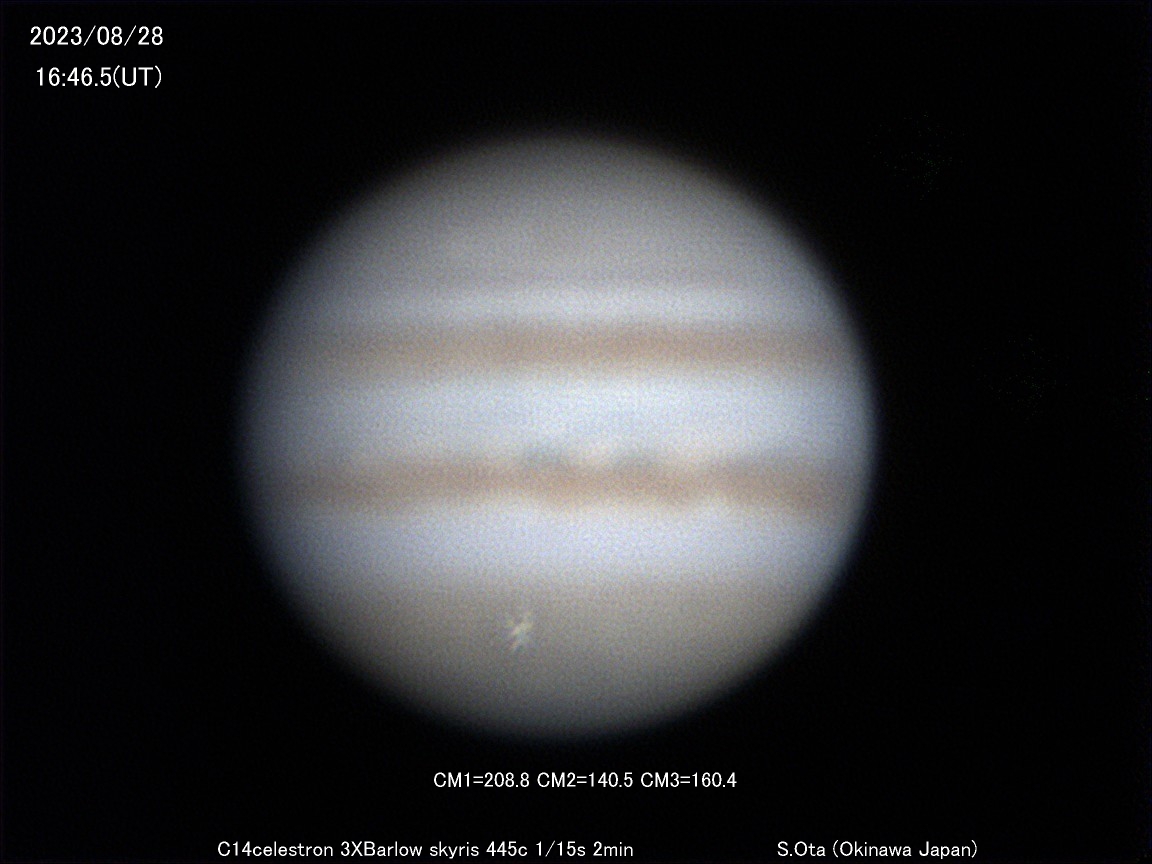 A new flash impact has been discovered in Jupiter's atmosphere. The discoverers of the impact are Tsutomu Ishibashi and Satoshi Ota who used a B390 filter and a color camera respectively. There is a third detection by a visual observer, Mitsuharu Morita visually observing the impact on the monitor between shootings. Later, new reports from different observers have been comunicated through ALPO-Japan and X/Twitter. These include a third video detection by Tadao Ohsugi, using a color camera, Yasuaki Tomita using a monocrome camera, and Masamichi Sekine also using a color camera. In addition, observers from China (Liu Qiqi from Zhengzhou and possibly others) have captured data of the impact with reports on X (Twitter). The image on the right is one of the frames in the video by Satoshi Ota. There are at least 7 independent observations of this impact, which makes this event one of the most widely observed impact flashes on Jupiter's atmosphere.
A new flash impact has been discovered in Jupiter's atmosphere. The discoverers of the impact are Tsutomu Ishibashi and Satoshi Ota who used a B390 filter and a color camera respectively. There is a third detection by a visual observer, Mitsuharu Morita visually observing the impact on the monitor between shootings. Later, new reports from different observers have been comunicated through ALPO-Japan and X/Twitter. These include a third video detection by Tadao Ohsugi, using a color camera, Yasuaki Tomita using a monocrome camera, and Masamichi Sekine also using a color camera. In addition, observers from China (Liu Qiqi from Zhengzhou and possibly others) have captured data of the impact with reports on X (Twitter). The image on the right is one of the frames in the video by Satoshi Ota. There are at least 7 independent observations of this impact, which makes this event one of the most widely observed impact flashes on Jupiter's atmosphere.
Methane-band images by observer Isao Miyazaki about 42 min after the impact do not show any impact scar on the planet confirming a small size of the body similar to previous flash impacts.
More information about the impact is currently available on:
2023-05-17
The small asteroid 2021 PH27 has the shortest orbital period of all known asteroids with a perihelion of only 0.133 AU, and could be an active asteroid. Its orbit makes this asteroid to experience very close passes to Venus, where if active, could be the progenitor body of a venusian meteor shower. On June 07, 2023 asteroid 2021 PH27 will pass at a minimum distance of Venus of 133,000 km offering a possible test towards its activity by producing a venusian meteor shower. Detecting this meteor shower in Venus is a very low probability event, but amateur observers could attempt to detect flashes on Venus night-side on June 07 and June 08 with moderate exposure times (0.1-0.5 s). If a successful observation occurs it will be the first Venus meteor shower detected and it would also proof the suspected and not confirmed activity of asteroid 2021 PH27.Dr. Javier Peralta (jperalta1 at us.es) leads part of the efforts to observe this potential meteor shower on Venus atmosphere. Observations can be analyzed with the software DeTect and communicated to Javier Peralta. Negative observations will also serve to characterize a threshold of activity on the asteroid.
References:
Carbognani et al. Is 2021 PH27 an active asteroid with a meteor shower detectable on Venus?, Monthly Notices of the Royal Astronomical Society: Letters, 511,L40–L44, https://doi.org/10.1093/mnrasl/slac004.
Arxiv version (public access to the publication)
2022-09-20
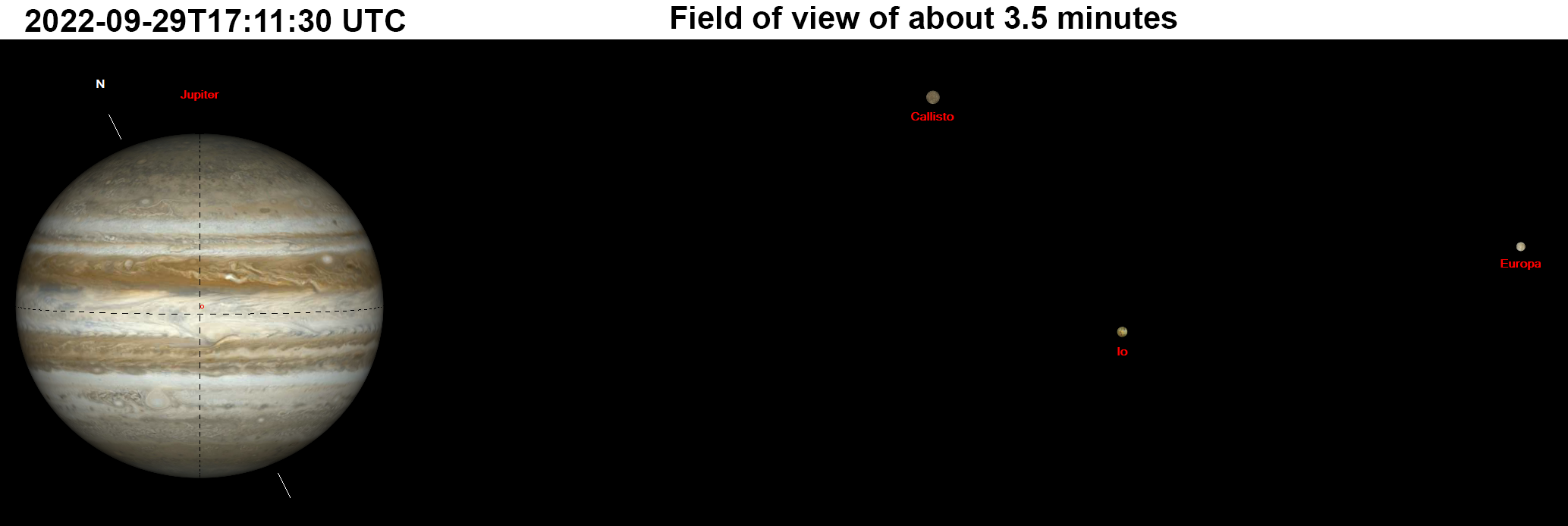 Unique Jupiter opposition on 26th September 2022: This year Jupiter opposition is the closest one in 70 years making Jupiter’s equatorial diameter as large as 49.9 arcsec as observed from Earth. The opposition occurs on 26 September 2022. A few days later, the Juno mission will make its 45 Perijove of Jupiter on 29 September at 17:11:30 UTC. During this perijove Juno will perform a very close flyby of Europa at an altitude of only 320 km obtaining the most detailed observations of its surface from space. Europa will be a target of 1.1'' during those days close to opposition.
Unique Jupiter opposition on 26th September 2022: This year Jupiter opposition is the closest one in 70 years making Jupiter’s equatorial diameter as large as 49.9 arcsec as observed from Earth. The opposition occurs on 26 September 2022. A few days later, the Juno mission will make its 45 Perijove of Jupiter on 29 September at 17:11:30 UTC. During this perijove Juno will perform a very close flyby of Europa at an altitude of only 320 km obtaining the most detailed observations of its surface from space. Europa will be a target of 1.1'' during those days close to opposition.
2022-05-28
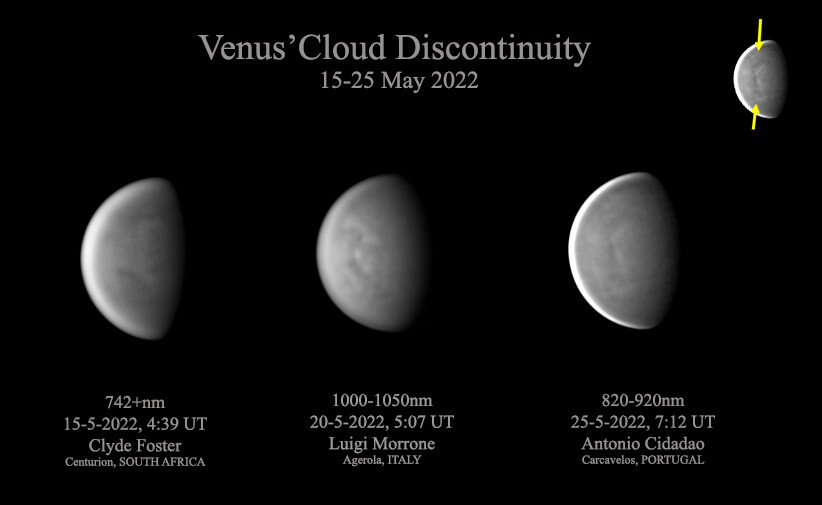
A large scale Cloud Discontinuity (CD) on Venus has been observed during the last weeks by amateur astronomers Antonio Cidadao, Luigi Morrone and Clyde Foster. This type of events represent a peculiar morphology of Venus clouds discovered recently and tracked last year over amateur observations. This time, a clear manifestation of Venus' CD was captured 5 times during May 2022 (5-10-15-20-25). The next observation of this feature is expected on 30 May and every ~5 days after it.
It will be very interesting to see when it will dissipate, so observations with IR filters are required. Imaging in UV may be useful too to confirm whether this wave phenomenon dissipates before arriving at the top of the clouds. Also, it is very important to observe every day to cover the global situation of the middle clouds.
Observations should be posted in the ALPO-Japan webpages and in the PVOL database of amateur observations (http://pvol.ehu.eus)
Javier Peralta from the Universidad de Sevilla (Spain) and Manos Kardasis (Greece) are coordinating a large effort to understand the global behavior of this feature.
Javier Peralta, jperalta1@us.es
Manos Kardasis, astromanos2002@yahoo.gr
Additional information:
2022-03-27
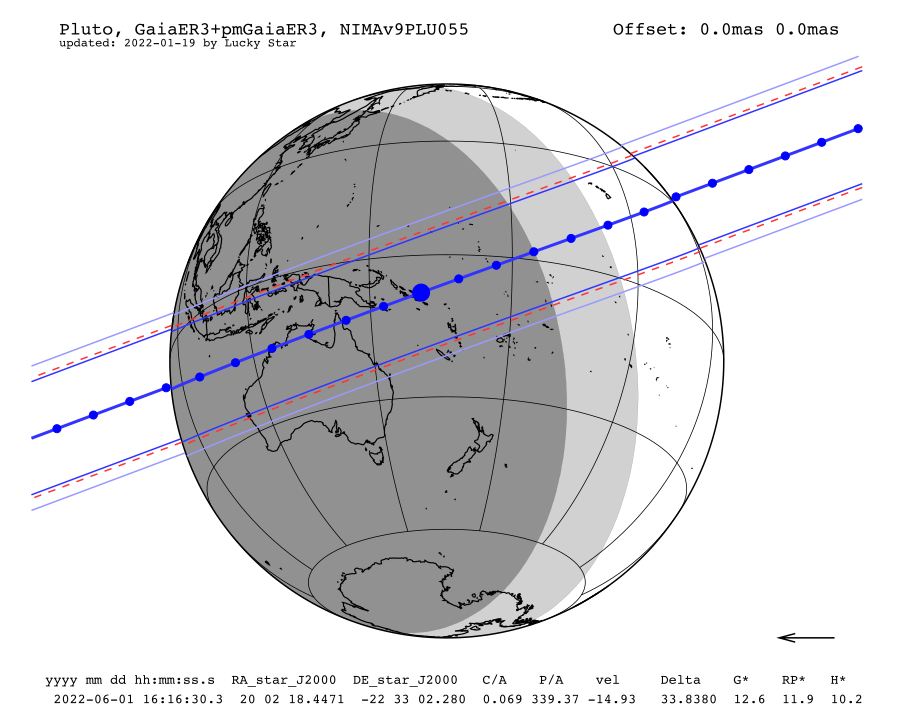 A stellar occultation by Pluto will occur on June 1, 2022, and will be observable from the South East Pacific at 16:16:30 UT. The map on the right contains information about the path of the shadow of Pluto over Earth's surface. Observations of this stellar occultation can help researchers to study the atmosphere of Pluto and its seasonal variation from comparison with data obtained by the NASA New Horizons spacecraft and previous occultations. In particular, observations obtained close to the center of the shadow, and requiring well located portable telescopes, will be very valuable to investigate the deeper layers of Pluto's atmosphere.
A stellar occultation by Pluto will occur on June 1, 2022, and will be observable from the South East Pacific at 16:16:30 UT. The map on the right contains information about the path of the shadow of Pluto over Earth's surface. Observations of this stellar occultation can help researchers to study the atmosphere of Pluto and its seasonal variation from comparison with data obtained by the NASA New Horizons spacecraft and previous occultations. In particular, observations obtained close to the center of the shadow, and requiring well located portable telescopes, will be very valuable to investigate the deeper layers of Pluto's atmosphere.
Important links
2021-10-16
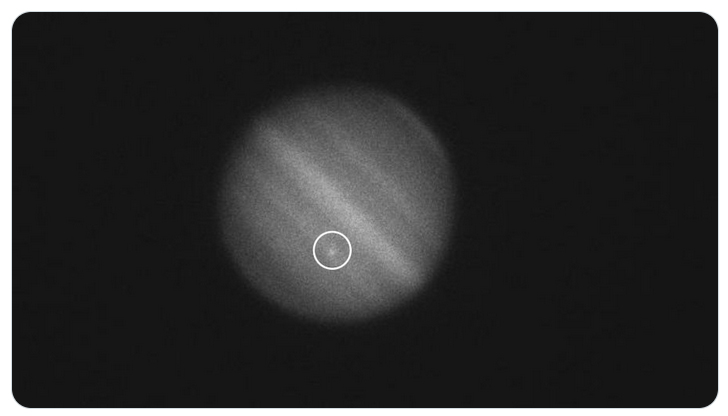 Ko Arimatsu, from Kwasan Observatory, Kyoto University, reports on the discovery of a new impact in Jupiter. The impact occurred on 15 October 2021 at
13:24 UT and it was observed as a 2 seconds flash with a dual imaging system called PONCOTS.
Ko Arimatsu, from Kwasan Observatory, Kyoto University, reports on the discovery of a new impact in Jupiter. The impact occurred on 15 October 2021 at
13:24 UT and it was observed as a 2 seconds flash with a dual imaging system called PONCOTS.
You can see the original discoverer announcement at:
https://twitter.com/OASES_miyako/status/1449206637391007747 . You can see the video of the impact in visible light on this youtube link.
The impact occurred approximately at +20ºPg and 40º L3. This location will be possibly observed by JunoCam on the Juno mission on its PJ37 orbit later today!
If you have observations of this impact flash please report those to Ko Arimatsu, as well as R. Hueso and M. Delcroix by email to:
[1]